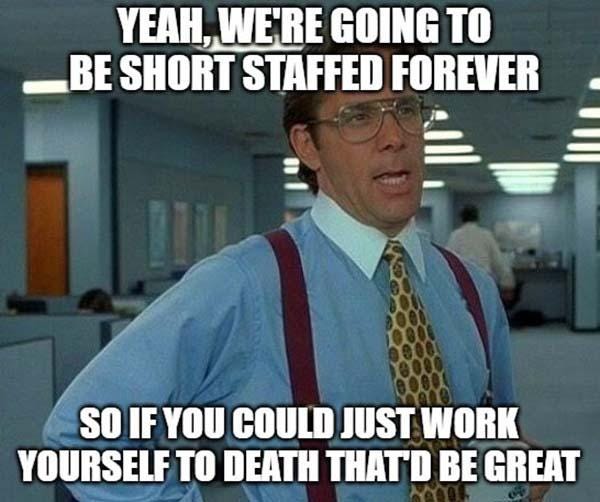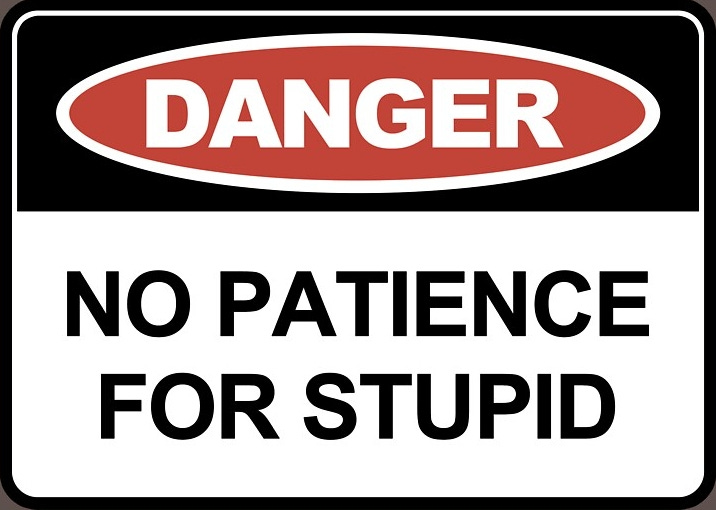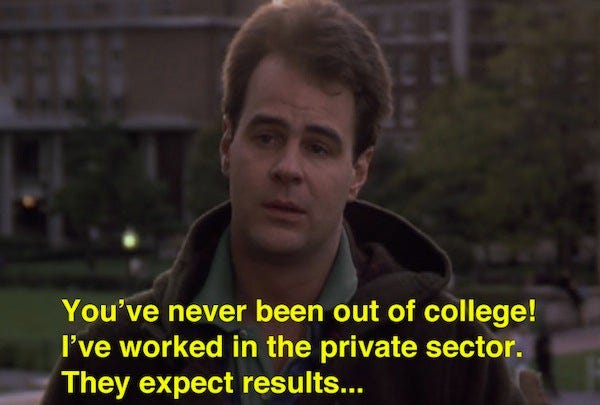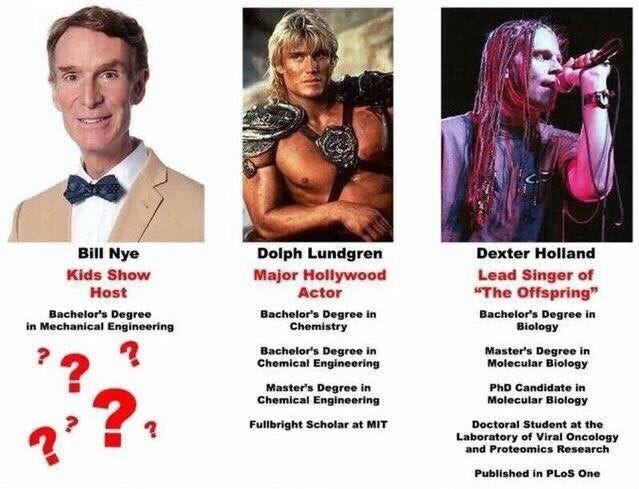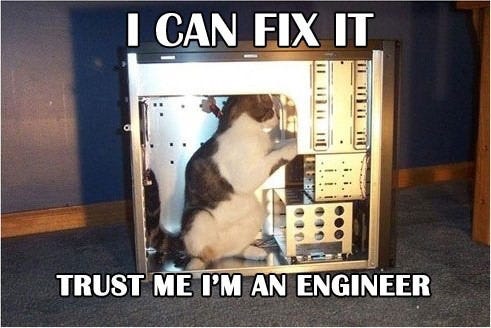While a very long ways from my current occupation, my formal schooling and most of my job history is in engineering.
I spent several years working at a microwave house that primarily did military contracting. The company I worked for had contracts for the HARM, AMRAAM, Tomahawk, the B-1B, and a dozen others I’ve long since forgotten about.
It was a good time for such things, we’d bid on a contract and the military would come in and very nearly literally throw money at us. Management, as is universal law, sucked, but we got to play with all the toys.
For all that I remember that job fondly, there were a lot of issues. There was a lot of crap work I hated, like repeatedly having to repair a dicing saw that was older than I was — I hated working on electro-mechanicals, especially ones that had to be waterproof — and I felt it was pretty clear that, given my lack of willingness to “Play The Game”, among numerous other issues, I was never going anywhere beyond my safe little lab.
It didn’t help that at the time I very much suffered from “What do I want to do with my life-itis?”.
So while working at that microwave house I got a call from a friend’s father, offering me a job at a start-up semiconductor manufacturing facility.
I jumped at it.
Ah, to be young and stupid again.
They told me I would have my own department (with a whole one report), be in on the ground floor (if you ever hear those words, run, don’t walk), promises were made, the sky was the limit, and other such bovine defecation that only twenty-somethings are silly enough to believe.
I ended up working there for a decade and a half.
It honestly wasn’t a bad place to work. We made a series of highly specialized semiconductor components — mostly for military applications, natch. Eventually we were bought out by our primary customer, they didn’t want our components going to their competitors. Mostly through attrition, I spent the last couple of years as plant manager. A job I was ill suited for, not good at, and the primary reason for my eventual resignation.
I’m a good, occasionally great, engineer, and a terrible, occasionally catastrophically horrible, manager.
In any event, over the years I got to see the good, bad, and indifferent of how engineers handle projects and problems in two very different fields. I was fortunate to have a really good mentor who taught me a lot of design and problem solving techniques, along with amplifying few less pleasant personality traits we had in common.
Science is the iterative process of creating a hypothesis, testing that hypothesis, and using the resulting data to refine your hypothesis into a theory, then using that to start the whole process over again. It is the search for an understanding of ourselves, the world, and the universe by attempting to continuously refining thoughts and ideas in the hopes of one day, eons from now, achieving ‘truth’ — whatever that might mean.
Engineers don’t care about any of that crap. We get paid to design and make shit, make it well, cheaply, and/or quickly — pick (at most) two.
I know Ohm’s Law is an approximation, at best, when you get to the quantum level. I know Newtonian Physics falls apart on a large enough or small enough scale. Don’t care, for the here and now they work just fine and that’s all I care about.
Scientists worry about getting published, Engineers worry about process design and failure modalities.
Thanks in large part to the commodification of education, the rise of credentialed employment, and the parasites publish-or-perish incentivizes, most studies are crap. I spend a depressing amount of time reading studies as part of my work, and the number that have grossly obvious P-Hacks is depressing. Beyond that, a huge number fail reproducibility, there’s rampant (especially in the age of Covid) Publication Bias, and dozens of other obvious issues that, frankly, pretty much everyone knows about. All leading up to the fundamental reality that most published research findings are false.
I’ve watched as an influential study with unexpected results inflamed already existing hostilities between factions of competing experts, caused a lot of people, including myself, to rethink some of our basic assumptions and program design decisions, only to have the industry discover later that once you deep dive into the obfuscated data set, it was all garbage. The researchers literally cut-and-pasted results between study participants to achieve the desired conclusion, then hid it so well that the truth wasn’t discovered for nearly a year, long after a lot of damage had been done.
It’s a mess, a terrible mess. It is an environment that lets people like Failure Fauci, who has been wrong on damn near everything from AIDs on, become the ultimate arbiter and gatekeeper for who and what gets money for research and publishing.
It’s a mess that desperately needs to be torn down to its bare foundations and rebuilt from there up. Starting, I think, with the notion that credentials count more than ideas, successes, or ability. Credentials mean jack-all. Especially given the pathetic nature of an education system where yesterday’s failures become today’s educators in a reductive hellscape perpetually descending into hitherto unimagined depths of idiocy.
The thing about Engineering is that it is much harder to fake it or hide your failures. You can’t P-Hack your way around the smouldering remains of your failed design. That’s not to say that some Engineers don’t try and fake it, I’ve known a few that were impressively good at accomplishing nothing with few seeming to notice, but, for the most part, eventually you have to produce and, in the end, your product either works or not.
Just ask Elizabeth Holmes, albeit the only way anyone thought that fantasy was ever going to work is they never asked (or, at least, never listened to) an engineer. Kinda like The Boring Company, because that was totally unforeseeable.
One of the things about making semiconductors from scratch is that things go wrong very easily. A vendor changes the formulation of the varnish you use as a gettering agent without bothering to mention it to you and suddenly your Iᵣ is measured in amps, your Tᵣᵣ is measured in weeks, and you have no idea why. From your perspective nothing on the line changed.
If you’re lucky they caught it at testing, if not then a production manager shipped it anyway because they’re only worried about making the monthlies. Either way, congrats, you now have a plant manager, a customer, or, most likely, both breathing down your neck.
Time for an FA — Failure Analysis.
Technically at our plant anyone could call an FA, but as a practical matter it was almost always the plant manager who did so. Once an FA was called the failure point was estimated, any product at that point and beyond was scrapped, the production people were sent home, and all the engineers, whether it was your product line or not, were going no where until there was a report containing a data-backed explanation for what went wrong and a plan for how to fix it and how to ensure it didn’t go wrong again.
FAs were stressful. They’re expensive and the longer they go on the more expensive it gets, so there’s a lot of pressure to find the failure point, figure out why it happened, and fix it quickly.
Easier said than done, especially when you learn that people, especially older Engineers, love elegant theories. Convincing someone to give up on their elegant theory in the face of contrary data can be a nightmare.
Getting ‘help’ could make things even worse. Sometimes, usually under pressure from a customer, they’d call in a ‘Real Scientist™’ to help, usually a professor from one of the many Unis in the area. These guys would come in, spout nonsense to managers and customers who thought an FPGA was a kind of investment account and an ASIC was a new brand of sports car. The Prof would then quickly bugger off, handing the real work off to grad students whom, unlike him, weren’t getting paid, but whom, like him, knew jack-all about actual manufacturing process and were full of book knowledge that was 60% too old to be useful and 20% too new to be useful.
Still, FAs were, especially early in my Engineering career, one of the times I learned the most. You are forced to take a deep dive into process design under a lot of stress. You learn things about the line, and how it really works (as opposed to those pesky process documents you wrote and the production manager told everyone to ignore) down to the nitty-gritty.
When you find the problem and, how to fix it, and, most importantly, how to prevent it from becoming a problem on down the line, you’ve accomplished something really meaningful and generally learned a lot about how to improve your process design in the future.
Governments worldwide failed miserably in their response to Covid. From buying into the ludicrous fear-pr0n videos put out by the CCP early on, the absurd British death projections, Fauci’s flip-flops on everything, forcing pointless NPIs on the public, lock downs that accomplish nothing but harm, mandating a vaccine so “safe” the manufacturers have legal immunity and the FDA wanted 75 years to release the data, and so effective they’ve had to change the definition of ‘vaccine’ and “fully-vaccinated” so fast and so often they’ve become Superluminal.
As with the 9/11, in every possible way the governmental response has been an utter, complete, and abject failure — government’s one, and apparently only, core competency. And, as with the response to 9/11, that failure has resulted in endless pointless theater that threatens to live on with all of the expanded governmental power, invasions of personal liberty, and destruction of public life that entails.
Governmental response to Covid desperately calls for, begs for a Failure Analysis.
Governments around the world failed their people, doing incalculable harm in the process.
What went right (very little), what went wrong (almost everything), how do we undo as much of the damage as is possible to undo, and how do we prevent it from ever happening again?
To anyone old enough, Covid looks like a rerun of The War on Terror show. Government loves this script so much they’re going to try and run it again, and again, and again. If not another “totes accidental” release of a “totes not gain-of-function” bat bug created by Lord Fauci and minions, it’ll be global warming, or cooling, or whatever they’re calling it this week.
If we were a serious people we would be demanding, preferably a high velocity lead-based demand, something very much like an FA. I’m not even sure how you’d do such a thing without it just being politicritters putting together some Pfizer, Moderna, and NIAD reps on a Very Serious Commitee that would put out a report in a year or so assuring us that, yes, indeed, Lee Harvey Oswald was Covid Patient Zero. If only he’d been vaccinated…
Hey, look… Putin!
Forget “Follow the Science”. Even if the people who chant it didn’t mean it as a quasi-religious paean to a concept they don’t remotely understand, it makes no sense and it frankly annoys the crap out of me that most of what they point to as “The Science” is actually Engineering — a much older discipline that uses many of the same tools.
Follow The Engineering.
Engineers know how to make stuff, break stuff, and how to hopefully keep the former from turning into the latter.







